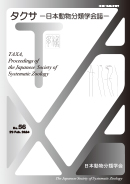最新号
選択された号の論文の11件中1~11を表示しています
- |<
- <
- 1
- >
- >|
JSSZ SYMPOSIUM 2023
-
2024 年 56 巻 p. 1-2
発行日: 2024/02/29
公開日: 2024/03/29
PDF形式でダウンロード (524K) -
2024 年 56 巻 p. 3-14
発行日: 2024/02/29
公開日: 2024/03/29
PDF形式でダウンロード (1925K) -
2024 年 56 巻 p. 15-18
発行日: 2024/02/29
公開日: 2024/03/29
PDF形式でダウンロード (927K) -
2024 年 56 巻 p. 19-23
発行日: 2024/02/29
公開日: 2024/03/29
PDF形式でダウンロード (731K) -
2024 年 56 巻 p. 24-27
発行日: 2024/02/29
公開日: 2024/03/29
PDF形式でダウンロード (647K) -
2024 年 56 巻 p. 28-30
発行日: 2024/03/29
公開日: 2024/03/29
PDF形式でダウンロード (541K) -
2024 年 56 巻 p. 31-33
発行日: 2024/02/29
公開日: 2024/03/29
PDF形式でダウンロード (467K)
ESSAY
-
2024 年 56 巻 p. 34
発行日: 2024/02/29
公開日: 2024/03/29
PDF形式でダウンロード (416K) -
2024 年 56 巻 p. 34
発行日: 2024/02/29
公開日: 2024/03/29
PDF形式でダウンロード (416K) -
2024 年 56 巻 p. 35-40
発行日: 2024/02/29
公開日: 2024/03/29
PDF形式でダウンロード (630K)
BOOK REVIEW
-
2024 年 56 巻 p. 41
発行日: 2024/02/29
公開日: 2024/03/29
PDF形式でダウンロード (306K)
- |<
- <
- 1
- >
- >|
